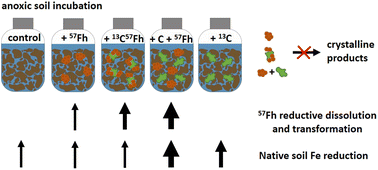New study shows that coprecipitation with glucuronic acid limits reductive dissolution and transformation of ferrihydrite in an anoxic soil
The new publication in Environmental Science: Processes and Impacts examines the transformations of ferrihydrite and the effects of organic matter.

Ferrihydrite, a poorly crystalline Fe(III)-oxyhydroxide, is abundant in soils and is often found associated with organic matter. Model studies consistently show that in the presence of aqueous Fe(II), organic carbon (OC)-associated ferrihydrite undergoes less transformation than OC-free ferrihydrite. Yet, these findings contrast microbial reductive dissolution studies in which the OC promotes the reductive dissolution of Fe(III) in ferrihydrite and leads to the release of associated OC. To shed light on these complex processes, we quantified the extent of reductive dissolution and transformation of native Fe minerals and added ferrihydrite in anoxic soil incubations where pure 57Fe-ferrihydrite (57Fh), pure 57Fe-ferrihydrite plus dissolved glucuronic acid (57Fh + GluCaq), a 57Fe-ferrihydrite-13C-glucuronic acid coprecipitate (57Fh13GluC), or only dissolved glucuronic acid (13GluCaq) were added. By tracking the transformation of the 57Fe-ferrihydrite in the solid phase with Mössbauer spectroscopy together with analysis of the iron isotope composition of the aqueous phase and chemical extractions with inductively coupled plasma-mass spectrometry, we show that the pure 57Fe-ferrihydrite underwent more reductive dissolution and transformation than the coprecipitated 57Fe-ferrihydrite when identical amounts of glucuronic acid were provided (57Fh + GluCaq versus 57Fh13GluC treatments). In the absence of glucuronic acid, the pure 57Fe-ferrihydrite underwent the least reductive dissolution and transformation (57Fh). Comparing all treatments, the overall extent of Fe(III) reduction, including the added and native Fe minerals, determined with X-ray absorption spectroscopy, was highest in the 57Fh + GluCaq treatment. Collectively, our results suggest that the limited bioavailability of the coprecipitated OC restricts not only the reductive dissolution of the coprecipitated mineral, but it also limits the enhanced reduction of native soil Fe(III) minerals.